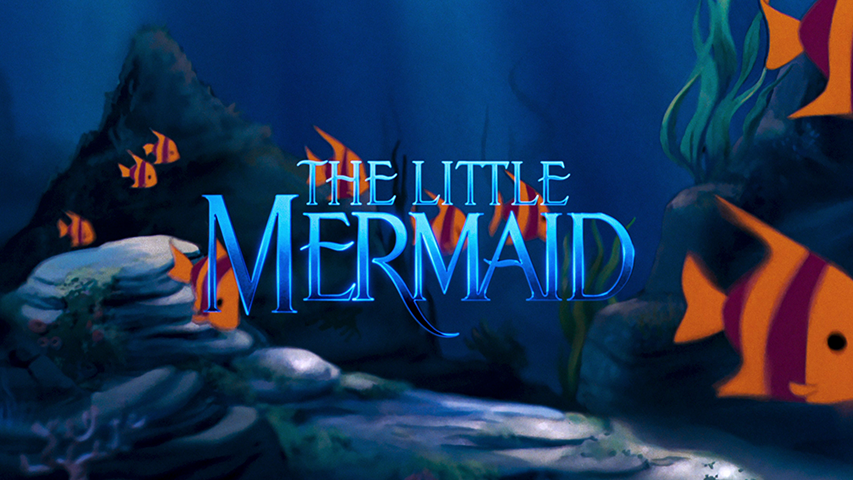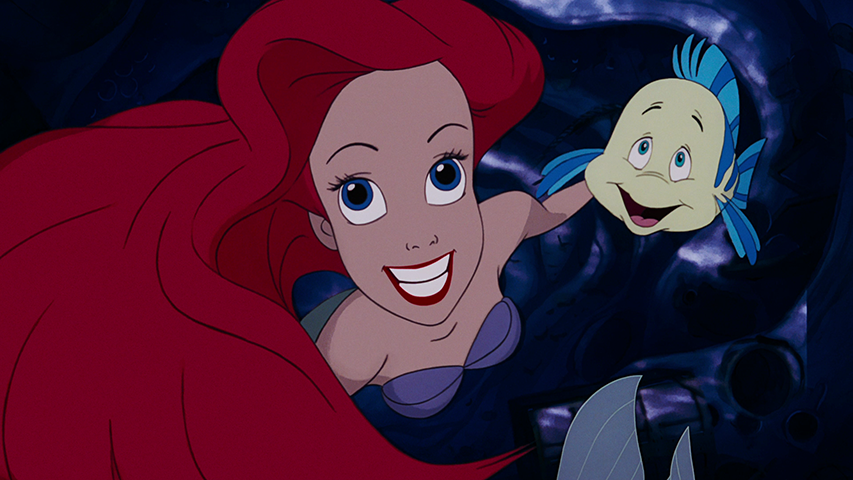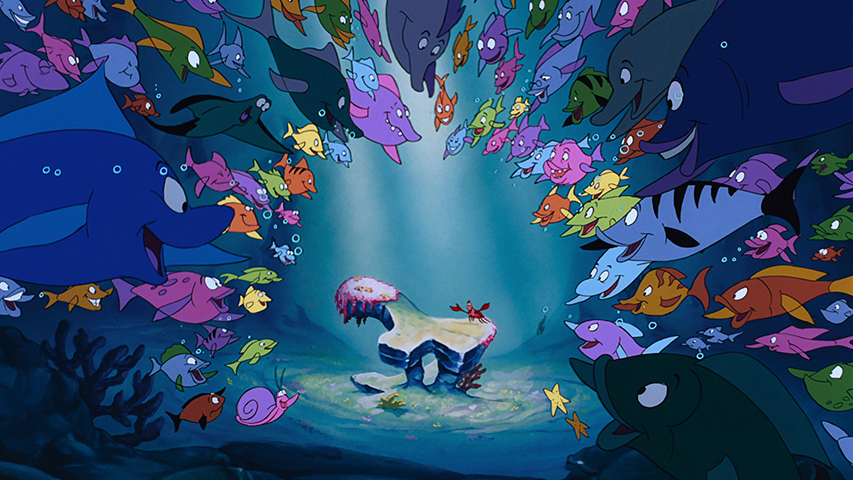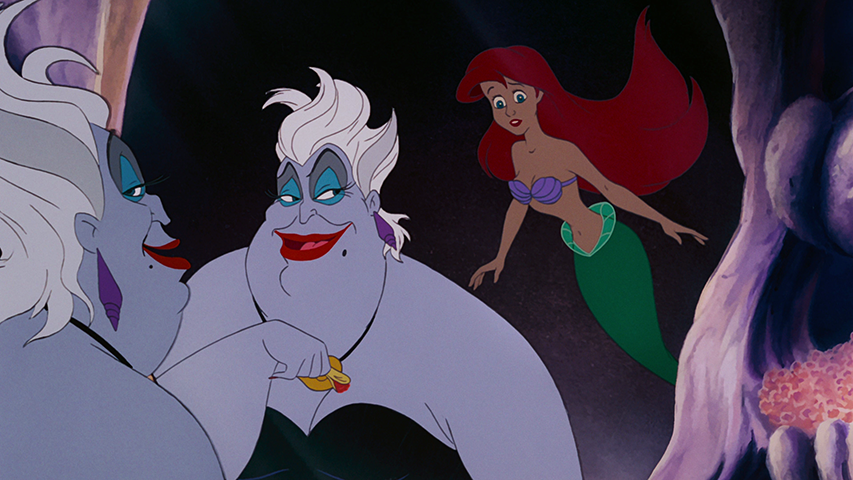| Reviews & Columns |
|
Reviews DVD TV on DVD Blu-ray 4K UHD International DVDs In Theaters Reviews by Studio Video Games Features Collector Series DVDs Easter Egg Database Interviews DVD Talk Radio Feature Articles Columns Anime Talk DVD Savant Horror DVDs The M.O.D. Squad Art House HD Talk Silent DVD
|
DVD Talk Forum |
|
|
| Resources |
|
DVD Price Search Customer Service #'s RCE Info Links |
|
Columns
|
|
|
LITTLE MERMAID, THE
In 10 Words or Less
The rebirth of Disney took place under the sea
The Movies
The arrival of The Little Mermaid in 1989 was a huge milestone for Disney Animation. It had been years since the studio had a big hit, and the arrival of this breakout Broadway-flavored blockbuster changed everything, leading to a slew of song-heavy features delivering diminishing returns over the next decade, until Pixar hit the scene and proved animation didn't need to be a musical to connect with audiences. It wasn't that The Little Mermaid wasn't just something different. It was something good, in a way moviegoers hadn't seen in a long time, which is why it holds up 30 years later.Based loosely on Hans Christian Andersen's classic story (leaving behind the very dark and depressing elements), this film tells the story of Ariel, an independent-minded mermaid, who longs to take part in the world of humans, especially after she rescues the handsome Prince Eric from an ocean storm. (It'd be interesting to see a breakdown of the Disney Princesses' beaus, to see what exactly they bring to the table beyond a pretty face. The answer is likely very little.) Ariel is always disobeying her father Triton--the king of the ocean--as she does when she makes a deal with Ursula the sea witch in order to get legs and try to find her happiness with Eric, at the cost of her melodic voice. And if she doesn't get true love's kiss (what is the deal with that idea?) in three days, she's a mermaid again and becomes Ursula's property.

Naturally, since this is a Disney film from the ‘80s, it's aimed squarely at the kids in the audience, with Ariel even given a trio of animal pals in the form of Sebastian the crab, Flounder...the flounder, and Scuttle the seagull. There's a lot of kid-friendly cuteness going on, but the story itself is a aiming at a bit of an older audience, with a truly terrifying villain in the form of Ursula, as well as some genuinely frightening moments. But despite touching on some relatively complex themes about growing up and not being defined by your family, the film still checks in at a very brisk 83 minutes, so there's only so much to absorb in terms of the story. When it becomes clear that everything is winding its way to an end, there's a definite sense of "That's it?," as things wrap up a little too quickly after all the set-up.
The lack of plot is, in large part, because, in the hands of composers Alan Menken and Howard Ashman, The Little Mermaid brought the theatricality and storytelling of Broadway to the animated Disney film, and did so with a host of song and "dance" numbers. There's a number of highly hummable show tunes over the course of the film, from Ariel's iconic "I Want" song--"Part of Your World"--to Ursula's dark "Poor Unfortunate Souls" and a lot of different kinds of songs in between. "Under the Sea", as sung by Sebastian, might be one of the catchiest songs ever to grace a Disney film, while "Kiss the Girl" (a questionable idea in today's culture) is a romantic, yet bouncy number. Not everything is top-shelf--Rene Auberjonois' "Les Poissons" is weirdly aggressive and creepy--but the average of hits is quite high, and spread over a sub-90-minute film, they cover a lot of real estate.
Matching the music in quality is the animation, an effort led in part by legendary artist Glen Keane. The last Disney animated film to be made with painted cels, it has a unique look amongst modern animated films, even if there is some minor CG animation integrated into the movie. The movements of Ariel and her castmates are so natural and smooth, with that added touch of artistry that just feels to be missing from most animation today (at least until Spider-Man: Into the Spider-Verse.) Everything in the film has a hand-drawn feel that just feels more exciting and tangible than something a computer pumps out. It's just all the more impressive to know people drew everything that goes into the film's huge climatic scene. That sense of humanity just seems appropriate for the matter at hand.

The Discs
The awkwardly-named Signature Walt Disney Collection Ultimate Collector's Edition of The Little Mermaid: Anniversary Edition arrives in a two-disc set, with one UHD disc and one Blu-ray, in a dual-hubbed black UHD keepcase, held in an embossed holofoil slipcover. Audio options on the UHD disc include English Dolby Atmos, Chinese 7.1 Dolby Digital Plus, , and French and Spanish 5.1 Dolby Digital, while subtitles are available in English SDH, French and Spanish. Audio options on the Blu-ray include English 7.1 DTS-HD Master Audio and French and Spanish 5.1 Dolby Digital, while subtitles are available in English SDH, French and Spanish.
The Quality
Simply put, the 2160p transfer on the UHD disc is stunning. Having watched this film in various formats over the years, it gets harder to imagine large improvements in quality, but this release is on an entirely new level. Even the moments that aren't impressive visually--like the fog-bound scenes early on--are a wonder to behold, as the detail and clarity allow the cel animation to truly shine. But where this film truly benefits from the move to UHD is in the HDR-enhanced colors, which are simply incredible, especially since their first appearance butts up against the previously mentioned dull fog. When the hues break through underwater, it verges on a religious experience. Naturally in a film that takes place in fantastical underwater locales and features a girl with bright hair and a vivid green tail, color's always been a big deal, but it's never looked this good before. The included Blu-ray looks great, but in UHD, there's a richness and vibrancy that will blow you away (with a silkiness that made me question if somehow motion smoothing had been turned on.) The image is also remarkably clean and free of any visual distractions, ensuring a delightful viewing experience. Watch any scene with Ursula and be amazed (and slightly disturbed) by what your eyes will see.If the visuals impress, the Dolby Atmos sound will knock you over. Again, listening to this UHD presentation makes for an entirely new experience, as sound effects are more pronounced and well-defined, atmospherics and score are more cleanly delineated in the mix and singing voices are remarkably clear and powerful. There are details in the audio that were never as prominent before, particularly during the more calamitous moments, with the low-end making its presence felt and the the surrounds put to good use in filling out the sound space and crafting the scenes, especially when magic is around, as musical effects get play in the sides and rear, while the overhead channels are more lightly utilized, mainly in supporting the score. With clean center-focused dialogue and rich, velvety sound overall, this is truly a memorable presentation.
The Extras
As is the norm, the 4K disc offers zero extras, so we turn to the Blu-ray. If you own the previous Anniversary Edition Blu-ray of this film, there are no new extra, because the Blu-ray included is the previous Blu-ray disc. Thankfully, that was a pretty loaded release, even if not all the extras are on the disc.The biggest extra is an audio commentary, featuring writers and directors Ron Clements and John Musker, as well as composer Alan Menken, with interview clips with Ashman sprinkled throughout. The directors spread about plenty of credit for the work on the film, while sharing details on the animation, as well as bits of trivia, like the issues that the protests in Tiananmen Square caused for the film, and how a test screening almost led to "Part of Your World" being cut from the movie. It's a quality track that meets its goals well.
Up next is "Alan Menken and the Leading Ladies" (15:45), a 30th anniversary conversation between the composer and a quintet of Broadway stars from Menken's Disney work: Jodi Benson (Ariel), Paige O'Hara (Beauty and the Beast's Belle), Judy Kuhn (the singing voice of Pocahontas), Lillias White (the lead muse from Hercules), and Donna Murphy ( Tangled's Mother Gothel). They talk about their work on the films, the changes in animation and Disney over the course of their films, and share tidbits and trivia from the productions. During the chat Menken begins playing his piano, leading the ladies to start singing their signature songs. The feel is very casual and light, making for a fun watch.
The 5:47 "What I Want From You Is...Your Voice" starts out with recording-booth footage and interviews with Will Ryan (Seahorse), Buddy Hackett (Scuttle), Samuel E. Wright (Sebastian), Patt Carroll (Ursula) and Benson in which they chat about their approach to voice acting and this film in particular. It's fascinating to watch the voice direction and to hear Carroll at work, as the disconnect between her voice and her look is the biggest of the group
"Stories From Walt's Office: Gadgets and Gizmos" (6:01) features two Disney archivists, who show off the various collectibles Walt Disney kept in his office (which was restored in Burbank, California, to be an ongoing exhibit.) The doo-dads are also put into the context of the history of Disney, as various trinkets eventually inspired well-known parts of the company.
The 5:40 "#Treasuresuntold" might be a bit hard to get through, as the stars of Disney Channel's Coop and Cami Ask the World bring A LOT OF ENERGY as they review some trivia about the film, seemingly in the same style as the series. The info is solid, and the actors are good, but it's a bit much.
For fans of instrument-free music, there's a music video (3:01) for "Part of Your World" , as performed by DCapella. This is a talented group of singers and the arrangement is good, but the aquarium setting for the video is a bit overbearing.
Clements and Musker return to talk about Harold the Merman (2:05), a deleted character, setting up animatics of his excised appearance in the film by explaining the reason he was cut. They are also on hand for the 13:13 Under the Scene: The Art of Live Action Reference, which looks at how they re-introduced the idea of shooting actors for the animation, which had been the standard in the studio's golden age. Through plenty of behind-the-scenes footage and archival material, the benefits of the process are made clear, and you get to see hoe Sherri Stoner influenced some of the most memorable elements of Ariel's character.
The 16:27 "Howard's Lecture", with insight from Benson, Clements, and Musker, offers a "lunchtime lecture" by lyricist Howard Ashman, in which he talks to the animators on the film about the art and history of the musical, musical theory and some early ideas about the songs in the film. Hearing Ashman's thoughts on the music and the very concept of the musical is so valuable, especially since he's no longer with us to share them otherwise.
The 1:09 Classic Bonus Previews basically explains that if you are looking for much of the bonus content from the Diamond or Platinum releases of the film, you have to use your digital code, and download them. Which brings us to the digital content. While there's certainly some convenience to this set-up, the presentation is less than ideal, as the order of content makes no sense, as the extras seem to be in a random order.
Things get started with one extra that's only been available digitally, the 5:50 "Part of Your World" - A Look Back. Similar to the leading ladies featurette, but with just Benson and Menken, this chat focuses on their famous song, and is accompanied by archival footage of its development in the recording booth. Alan Menken and Jodi Benson discuss the impact of "Part of Your World", nearly cutting the song from the film and its legacy. They also discuss the film's impact on Disney animation.
There are storyboards with audio for several scenes (and more complete pencil animation for one) that were either cut down, replaced or removed from the film. Each scene includes an introduction from either Clements or Musker, who explain why the decision was made and share some info about the production. You also get to hear scratch vocal tracks, letting you hear the earliest incarnations of these characters, along with some very minimalist designs for the characters.
- "‘Fathoms Below'" - Alternate Version (2:31)
- "Backstage with Sebastian" (1:44)
- "Advice from Sebastian" (1:31)
- "Fight with Ursula" - Alternate Ending (6:53)
- "Sebastian Lost in the Castle" (1:54)
- "'Poor Unfortunate Souls'" - Extended (8:35)
I will not lie, seeing there was a music video for a Carly Rae Jepsen cover of "Part of Your World" (3:40) was an exciting moment, and the video didn't disappoint, even if it wasn't as energetic as her usual output. There's also a video for Ashley Tisdale's version of "Kiss the Girl" (3:26), but this Disney Pop-ified track doesn't fare as well.
If you want to hear a song that didn't make it into the final film, the 3:00 "Silence is Golden" Song Demo lets you hear a track that eventually was replaced by "Poor Unfortunate Souls". Clements is on hand to explain what happened, before Menken's demo performance plays over a piece of concept art. Listening to the tango-inspired tune, it's clear the right decision was made, but there's nothing inherently bad about this song (nor Menken's performance.)
Wrapping up the musical portion of the digital extras are five sing-along songs from the film, presented via animated lyric videos, including "Part of Your World" (2:51), "Les Poissons" (1:24), "Under the Sea" (3:06), "Poor Unfortunate Souls" (5:41) and "Kiss the Girl" (2:44). Though "Les Poissons"--which sounds a lot like "Be Our Guest"--is an unusual inclusion for the kids likely to be the main audience for these videos, at least its inclusion didn't preclude a better song from being represented.
For a theme park tie-in, there's "Behind ‘The Ride that Almost Was' with the Disney Imagineers" (5:55), which allows the creative and technical folk responsible for designing a Little Mermaid Disney Park ride to talk about their vision and show concepts of a rie that was never completed. If you want to check out what it could have been like, there's a CGI first-person "Ride the Attraction" (4:18), which simulates the would-be ride, with an optional commentary explaining the concept and ideas that go into building a ride. You can see where some of the ideas eventually made their way to the Walt Disney World ride in Orlando. Then, the 4:50 "Part of Her World: Jodi Benson's Voyage to New Fantasyland" offers a thinly-veiled promo for the section of Walt Disney World that holds the Little Mermaid ride (as well as one of the resort hotels), as Benson and her kids check out the then-newly renovated part of the park, ride the Ariel ride and talk about their favorite parts of Fantasyland.
"The Little Mermaid: The Story Behind the Story" (11:31) goes into solid depth on the original Andersen tale and the man who wrote it, including paying a visit to his museum in Norway, as Clements and Musker talk about the original story, their adaptation and the 1940s attempt by Disney to make a movie version (which is seen through archival document and concept art.) The curator of the Andersen museum adds in details on the author's life, and points out parallels between Ariel and Andersen. It's amusing to hear the directors discuss how they approached the darker elements of the story.
"@Disney Animation" (10:49) focuses on the animators working for the studio, mixing in Clements and Musker, as well as younger animators who were influenced by The Little Mermaid. There are peeks at the culture at the office, whether it's work-time or break-time, all of which seems almost too good to be true. It would make one heck of an HR recruiting video.
"Treasures Untold: The Making of The Little Mermaid" (45:42) is a six-part documentary about the production of the film, setting the stage with Disney's woes in the ‘80s, moving through the early development, the introduction of Broadway elements, through the low expectations at the box office. The roster of commentators is lengthy and varied, including executives from Disney at the time like Jeffrey Katzenberg, cast and crew from the movie and film industry mainstays like Leonard Maltin, Frank Oz and, of all people, John Waters. Though the commentary is hugely informative, this is the big-picture history of this movie.
"Storm Warning: The Little Mermaid Special Effects Unit" (8:42) looks at the team responsible for the water animation and other non-character work. For animation fans, this is catnip, as the directors and effects leads watch scenes from the film and discuss how it was done. There's also a visit to the Disney archives, to look at the original animation elements, which gives more insight into the effort to create the underwater world of Ariel and company.
There's no explanation as to what the 2:37 "Under the Sea Early Presentation Reel" was for, but it presents a montage of concept art, pencil sketches and storyboards, set to a demo version of "Under the Sea". It's interesting to see all the different takes on Ariel, none of which really ended up as the finished product, even if several could have worked.
From an educational angle comes "Disneypedia: Life Under the Sea" (8:27), a compact, yet detail-packed lesson about the world under the water, using the characters in the film as a jumping-off point. This is most likely going to be of interest to the younger viewers watching.
The digital extras wrap with the Original Theatrical Trailer (2:17), a plot-heavy reveal-fest that sells the film on the songs and nostalgia for the classic fairy-tale Disney films.
For some reason, four extras from the previous releases did not make the leap to this release, either on the physical disc or the digital version: The Little Match Girl, John & Ron Make Caricatures of Each Other, Animators Comment on their Characters, and The Little Mermaid Handshake. The reason for their absence is unclear, but not including The Little Match Girl is a bummer (even if the movie itself is a bigger bummer.)

The Bottom Line
Coming on the heels of a down decade for Disney Animation, The Little Mermaid had a lot riding on it, but the introduction of Broadway-style musical elements made it stand out from the pack, while also influencing a generation of Disney films to follow (for better and worse.) In the end, the film is greatly entertaining and beautifully made, featuring gorgeous animation and remarkably catchy music. It may be a cliche, but the UHD disc makes watching this film feel like it's the first time all over again, as it looks and sounds incredible, and though there are no new extras to check out, the majority of those previously available are still here (even if some are only available via streaming.) If you don't own this film, this is a fantastic way to add it to your collection, but repurchasing it for the 4k upgrade is probably best advised for those updating from DVD or those with very large TVs.
Reviewer's Bias*
Loves: animation, musicalsLikes: Disney
Dislikes: Digital extras, not getting new extras
Hates: The musical-heavy wake of The Little Mermaid
Francis Rizzo III is a native Long Islander, where he works in academia. In his spare time, he enjoys watching hockey, writing and spending time with his wife, daughter and puppy.Follow him on Twitter
*The Reviewer's Bias section is an attempt to help readers use the review to its best effect. By knowing where the reviewer's biases lie on the film's subject matter, one can read the review with the right mindset.
|
| Popular Reviews |
| Sponsored Links |
|
|
| Sponsored Links |
|
|
| Release List | Reviews | Shop | Newsletter | Forum | DVD Giveaways | Blu-Ray | Advertise |
|
Copyright 2024 DVDTalk.com All Rights Reserved. Legal Info, Privacy Policy, Terms of Use,
Manage Preferences,
Your Privacy Choices | |||||||














